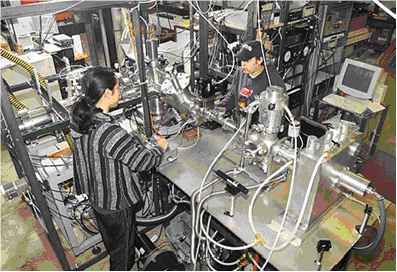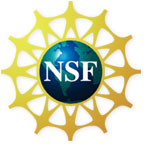Thrust 3: Novel linear and nonlinear spectroscopies


Top photograph of graduate student Scott Heinbuch and undergraduate Jutin Lo of Colorado State University, working with the new nanocluster spectroscopy apparatus. The compact capillary discharge EUV laser photoionization source can be seen on the lower right of the photograph.
The EUV region of the spectrum is used
by thousands of scientists for element-specific and surface-specific
spectroscopies. New, small-scale, EUV sources will make
it possible to implement many techniques currently done
at large-scale facilities in individual research labs. Furthermore,
given the short-pulse nature of these EUV sources (femtosecond
for the HHG sources), new opportunities will arise for extending
techniques such as photoelectron spectroscopy into the time
domain, and for exploring nonlinear-optical properties of
matter in a new region of the spectrum.
We are constructing testbeds that will use the compact EUV
sources developed at the Center to study challenging scientific
problems. In the longer-term, our strategic plan is to develop
small-scale analytical instruments for a wide range of applications.
In the initial year of the EUV ERC, we are working to implement
the following testbed systems to demonstrate the utility
of small-scale EUV sources.
Projects
Measurement of quasi-ballistic heat transport at nanoscale interfaces for the first time, using ultrafast coherent EUV beams (collaboration between CU, UC – Berkeley and MIT). [M. Siemens et al, Nature Materials 9 , 26 (2010). |
 |
Probing of coupled electron and nuclear dynamics in polyatomic molecules using coherent electrons and x-rays. This work was featured on the cover of Science. [W. Li et al., Science 322 , 1207, (2008)] |
 |
A very-sensitive testbed for probing of acoustic dispersion and surface deformation was developed using EUV light for the first time. This testbed is several orders of magnitude more sensitive than the equivalent optical probe. Photo-thermal and photo-acoustic transients and acoustic dispersion on nanoscale dimensions were probed with EUV light using a high harmonic source. This work is now being extended to study heat transport in devices on nanoscale dimensions below 200nm (collaboration with MIT). [R. Tobey et al., Applied Physics Letters 89 , 091108, (2006); R. Tobey et al., Applied Physics Letters 85 , 564, (2004); M. Siemens et al., Applied Physics Letters 94, 093103 (2009)] |
 |
• Spectroscopy of metal-oxide nanoclusters was successfully demonstrated using a desk-top sized EUV laser as a single photon ionization source. [S. Heinbuch et al., Optics Express 13 , 4050, (2005); F. Dong et al., Journal of Chemical Physics 124 , 224319, (2006); F. Dong et al., Journal of Chemical Physics 125 , 154317, (2006); S. Heinbuch et al., Journal of Chemical Physics 125 , 154316, (2006); F. Dong et al., Journal of Chemical Physics 125 , 164318, (2006); S. Heinbuch et al., Journal of Chemical Physics 126 , 244301 (2007); F. Dong et al., Journal of the American Chemical Society 130 , 1932, (2008); S.-G. He et al., Journal of Physical Chemistry A 112 , 11067, (2008); F. Dong et al., J. Am. Chem. Soc . 131 , 1057, |
|
First study of chemical reactions of industrial importance using of desk-top size capillary discharge EUV laser as single photon ionization source of nanoclusters. [ F. Dong et al., Journal of the American Chemical Society 130 , 1932, (2008); S.-G. He et al., Journal of Physical Chemistry A 112 , 11067, (2008).] |
|
First demonstration of spectroscopic identification of material ablated using a focused EUV laser (collaboration between CSU, UC – Berkeley and JMAR). This industrial project is aimed at the development of a new set of analytical tools for nanotechnology. [M Berrill et al., Journal of the Optical Society of America B 25 , B32, (2008)] |
|
Demonstration of ablation of 82 nm holes for LIBS nanoprobe. [G. Vaschenko |
 |
Photoemission spectroscopy of novel electronic materials was demonstrated with higher resolution using a compact high harmonic source (collaboration with CU physics). [J. Koralek et al., Physical Review Letters 96 , 017005, (2006); J. Koralek et al., Review of Scientific Instruments 78 , 053905, (2007)] |
|
Use of attosecond electron recollisions during the process of high harmonic generation to probe molecular structure and dynamics. Observation of phase shifts in harmonic emission due to the structure of the molecule for the first time. [X. Zhou et al., Physical Review Letters 100 , 073902, (2008); N. Wagner et al., Physical Review A (2008)] |
 |
Use of ultrafast x-rays to initiate and study ultrafast radiation femtochemistry for the first time (collaboration with Kansas State ). [E. Gagnon et al., Science 317 , 1374, (2007)] |
 |
Measurement of the orientation dependence of single photon ionization of a molecule for the first time. [I. Thomann, J Physical Chemistry A 112 , 9382 (2008)] |
|
Laser-assisted photoemission was observed from a surface for the first time. This work has important implications for observing attosecond dynamics in solids. To date, such dynamics have been observed only in gas phase (collaboration with Kaiserslautern ). [L. Miaja-Avila et al., Physical Review Letters 97 , 113604, (2006); G. Saathoff et al., Physical Review A 77 , 022903, (2008)] |
 |
Measurement of charge transfer processes between an adsorbate and surface in real time for the first time. This measurement was made on Pt, which is an important catalytic surface. [L. Miaja-Avila et al., Physical Review Letters 101 , 046101 (2008)] |
|
Identification of high hydrogen storage capacity materials using single photon ionization mass spectroscopy using a desk-top size EUV laser. [F. Dong et al., submitted Journal of the American Chemical Society] |
 |
Measurement of the highest frequency (50 GHz) surface acoustic wave propagation in nanostructures using ultrafast HHG beams. [M. Siemens et al. Applied Physics Letters 94 , 093103, (2009)] |
|
Observation of the birth of a highly excited Feshbach resonant state in soft x-ray induced molecular dissociation. [A. Sandhu et al., Science 322 , 1081 (2008)] |
|
First characterization of element-specific dynamics in magnetic materials [Physical Review Letters 103 , 257402 (2009)] |
|
First real time imaging of electron orbitals as a molecule dissociates .[ W. Li et al. submitted (2010)] |
|
Development of a femtosecond transient absorption apparatus for molecular dynamics |
|
Electromagnetically induced transparency principle demonstrated in EUV transitions in He [ Z.-H. Loh, et al., Chem. Phys. 350 , 7 (2008)] |
|





